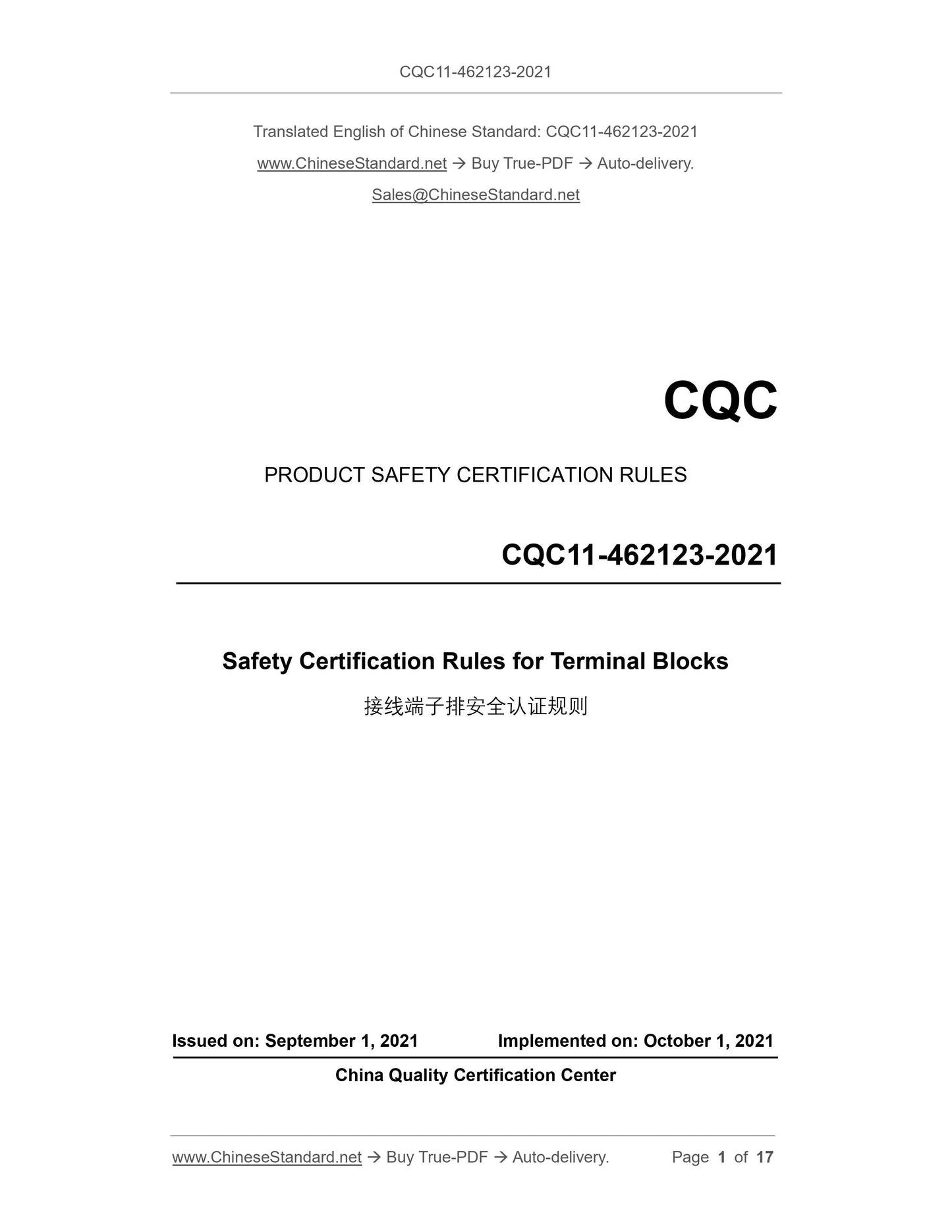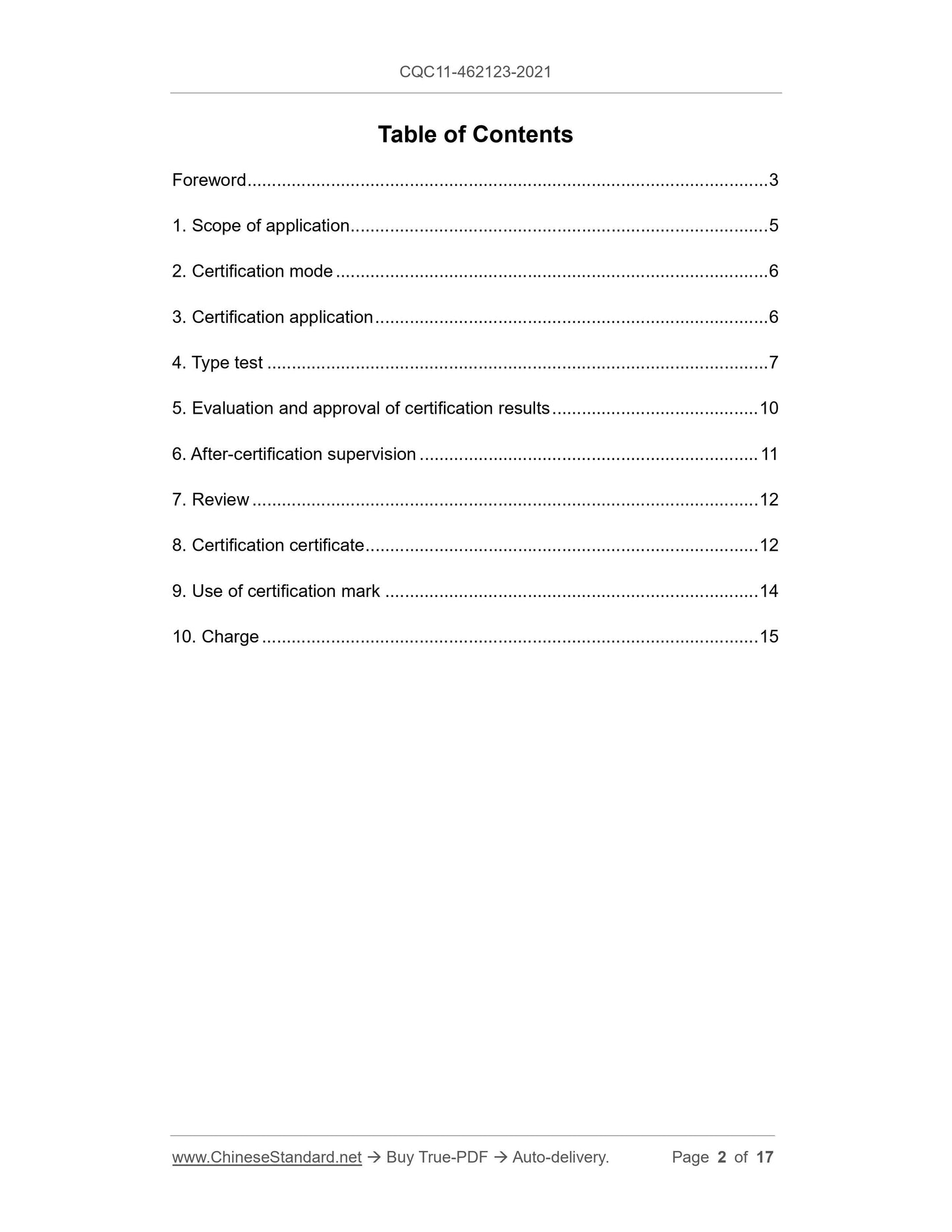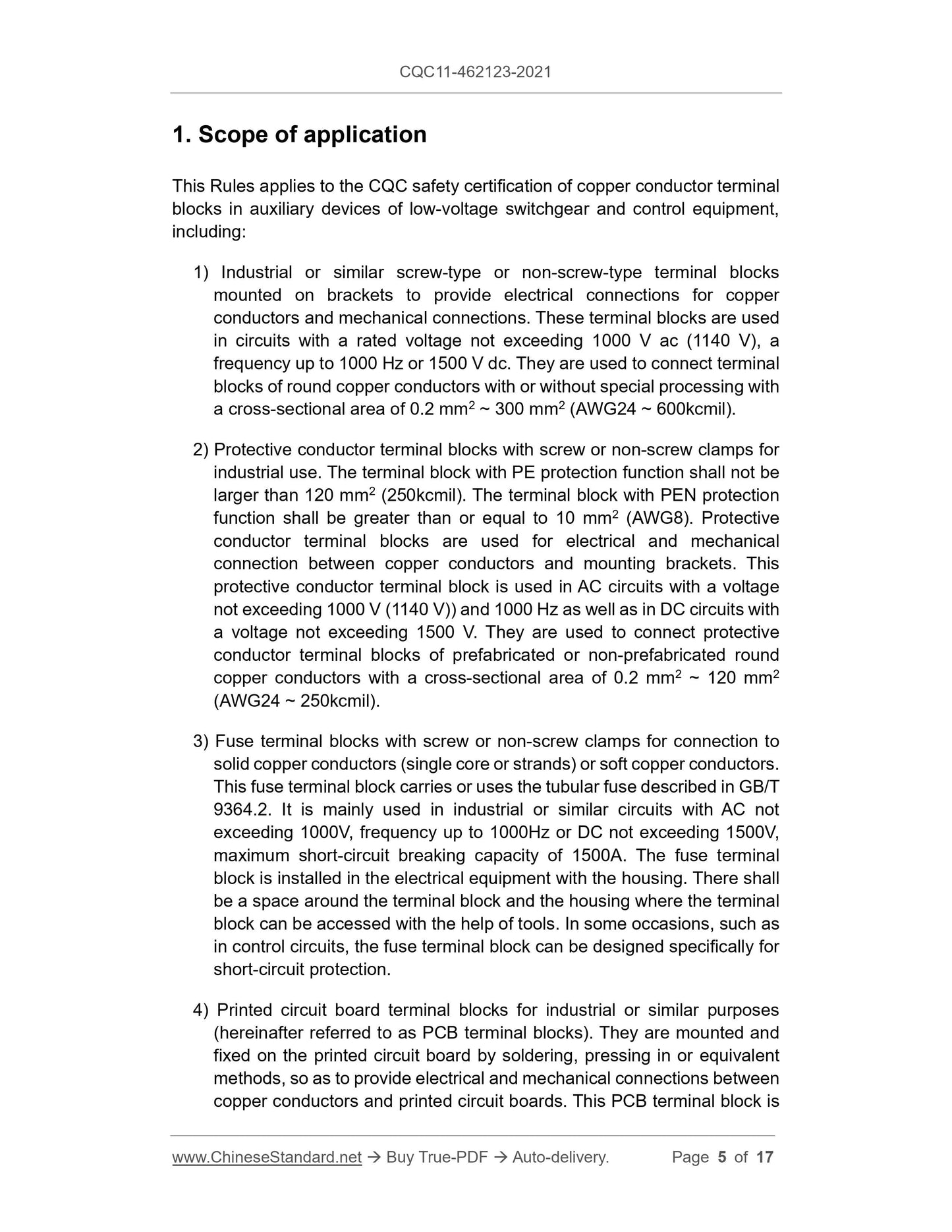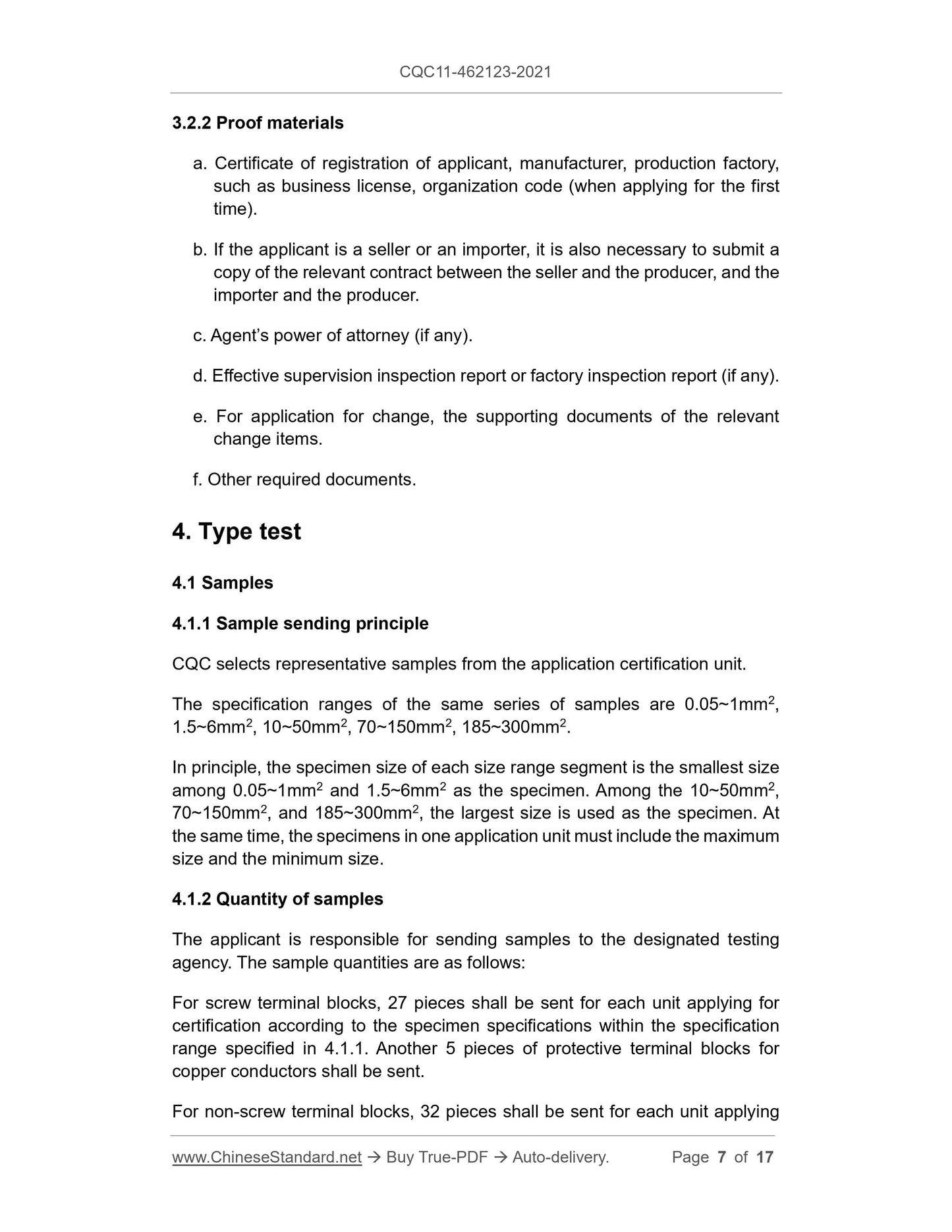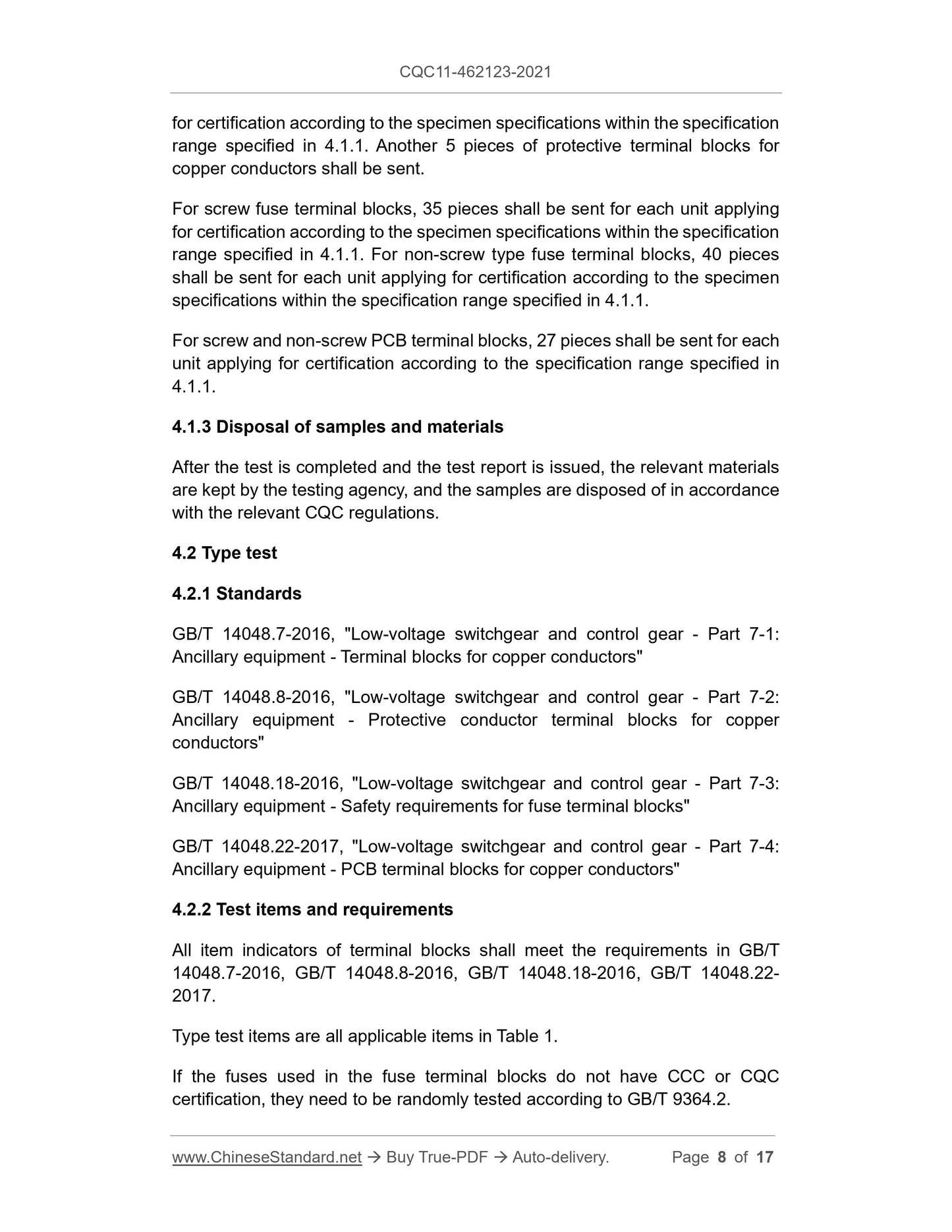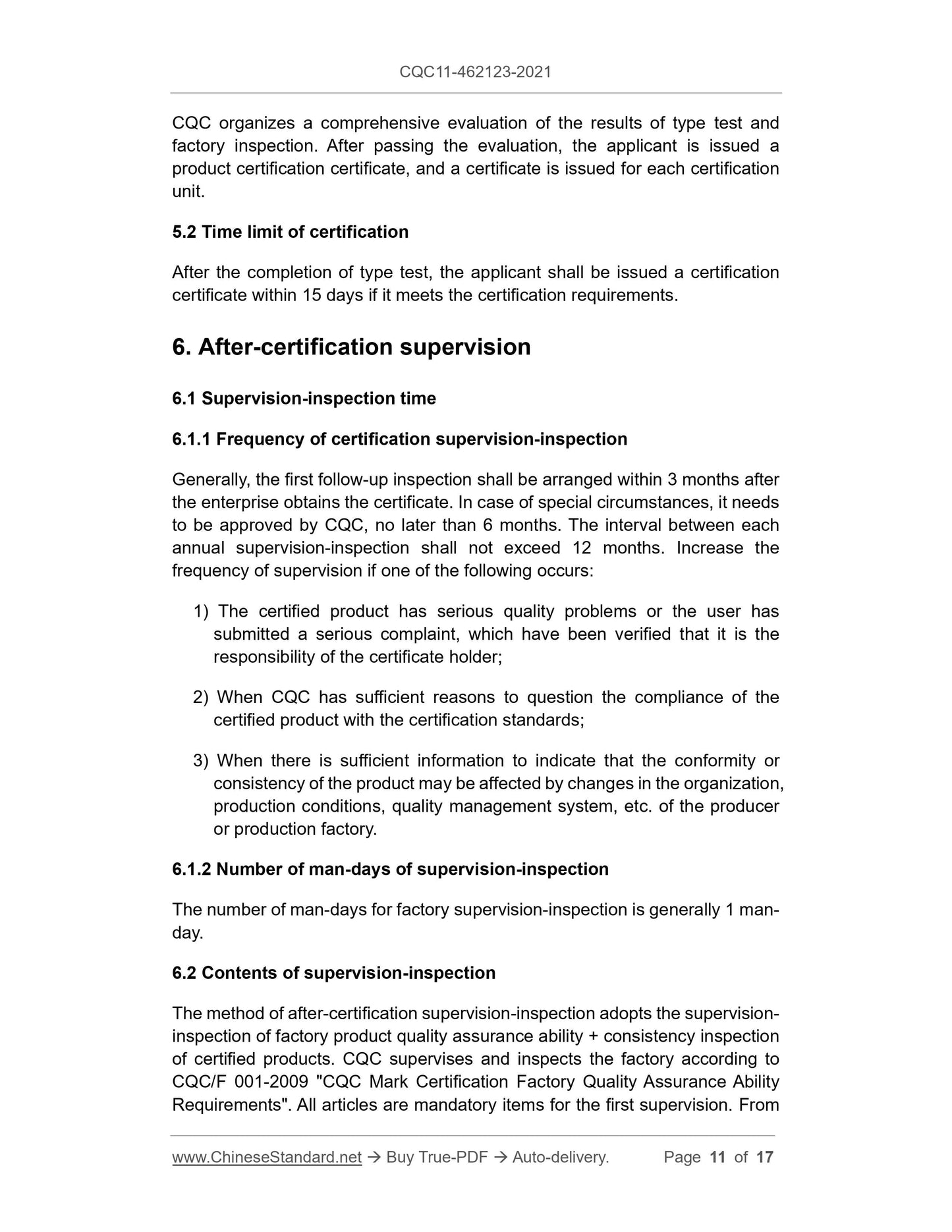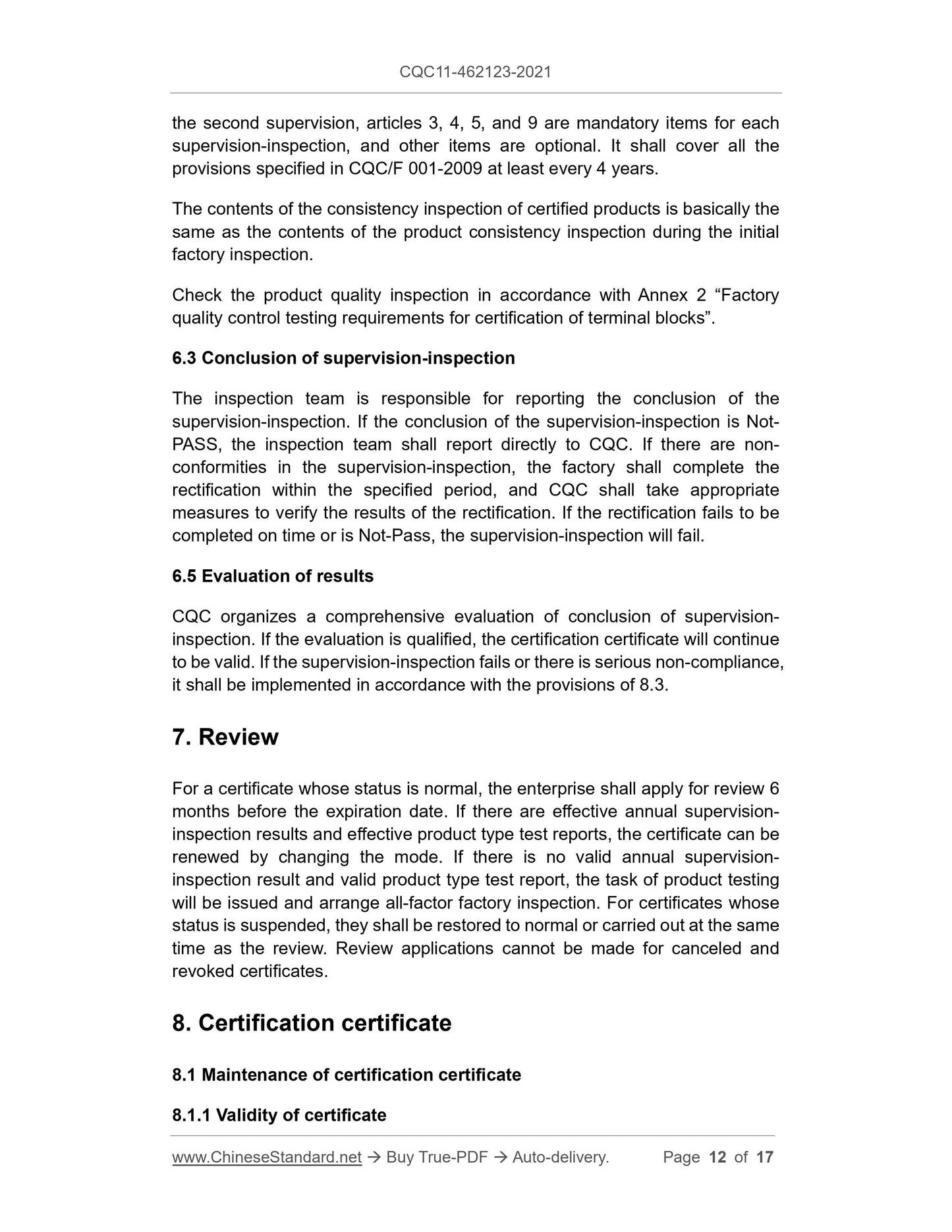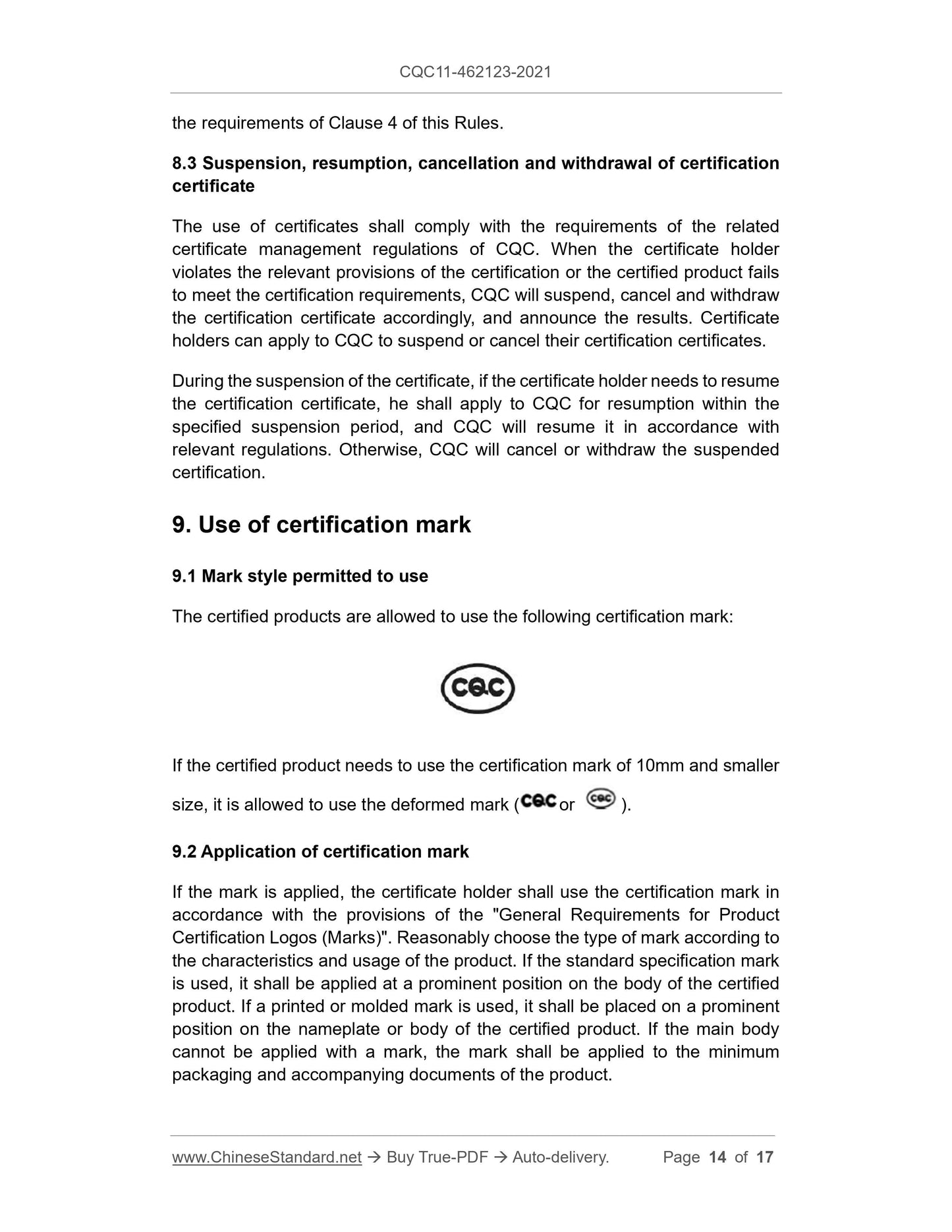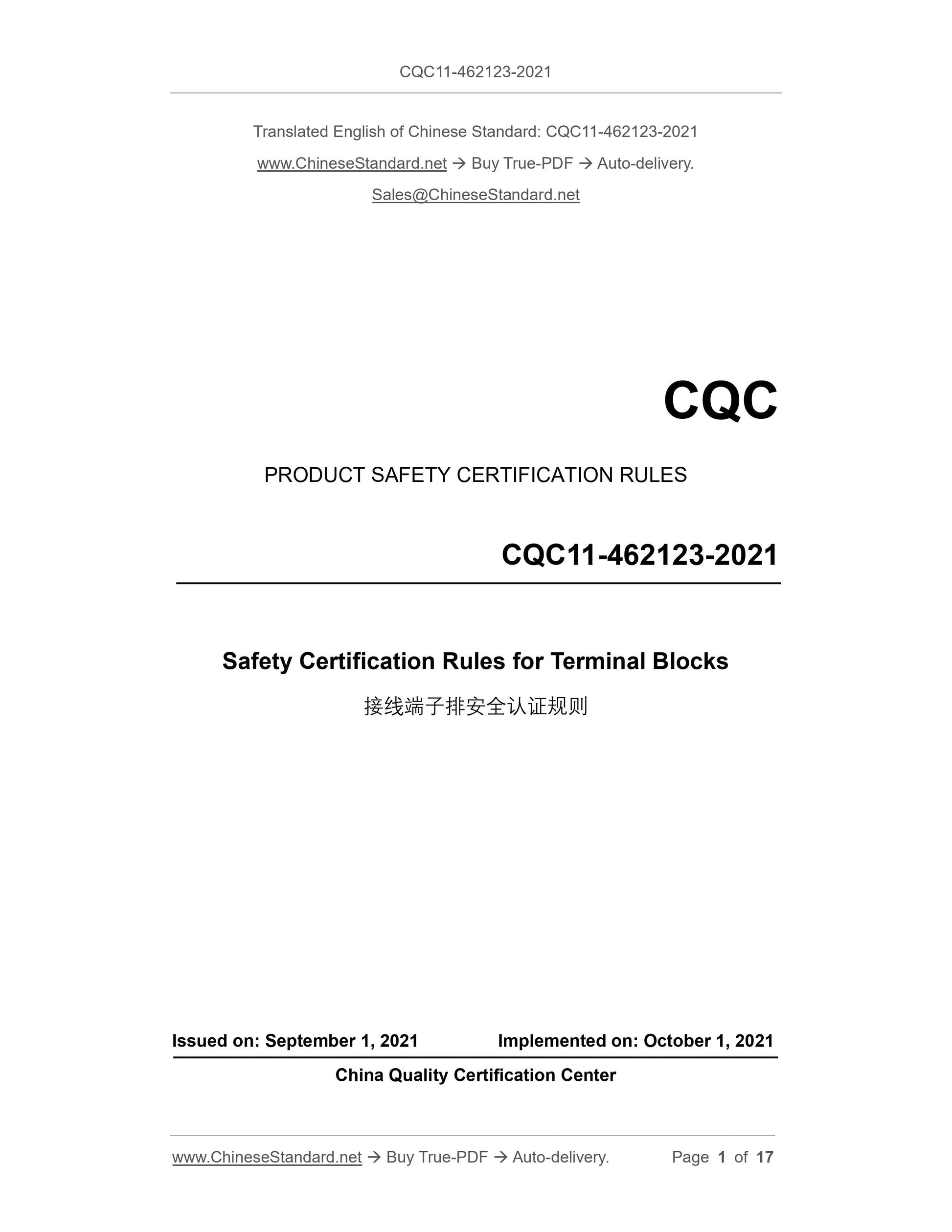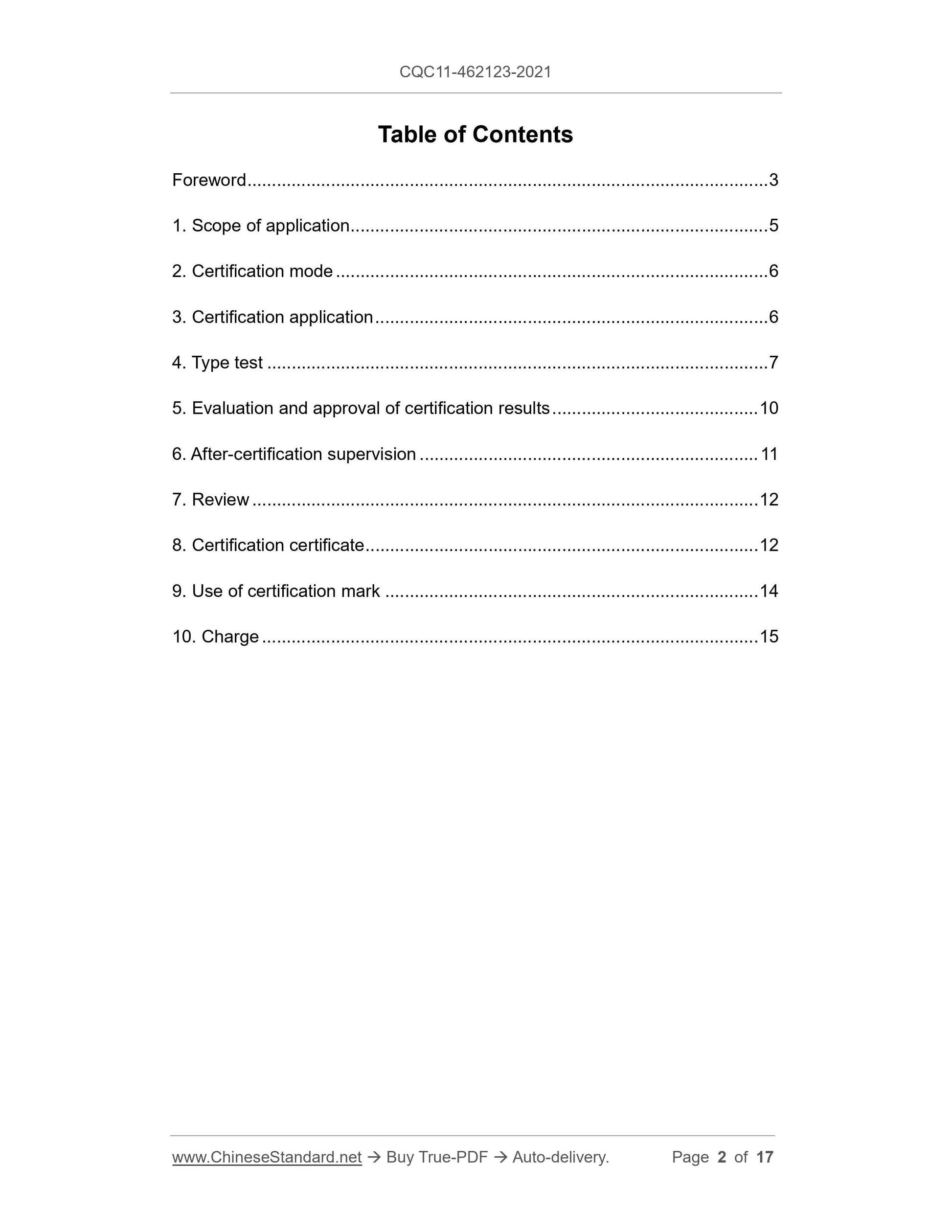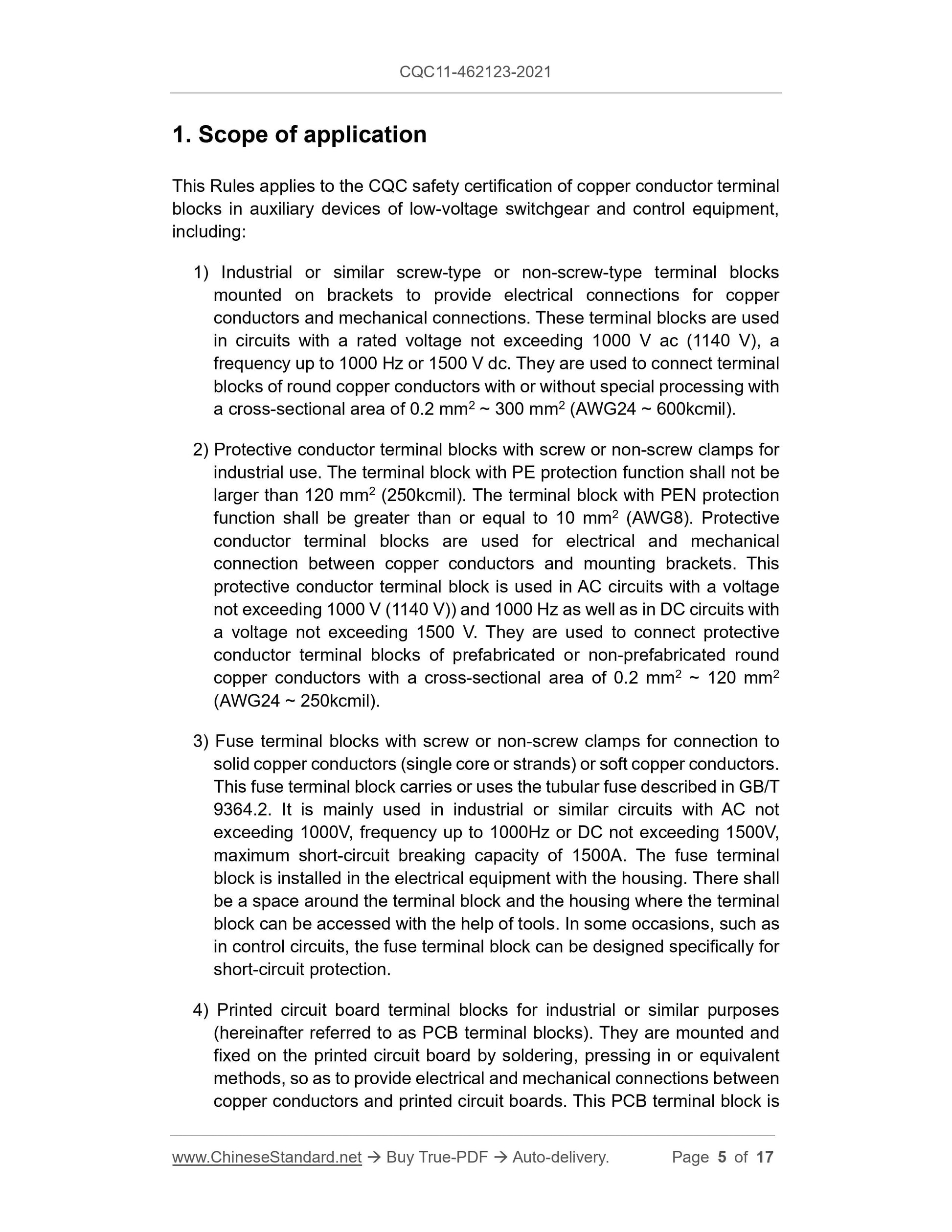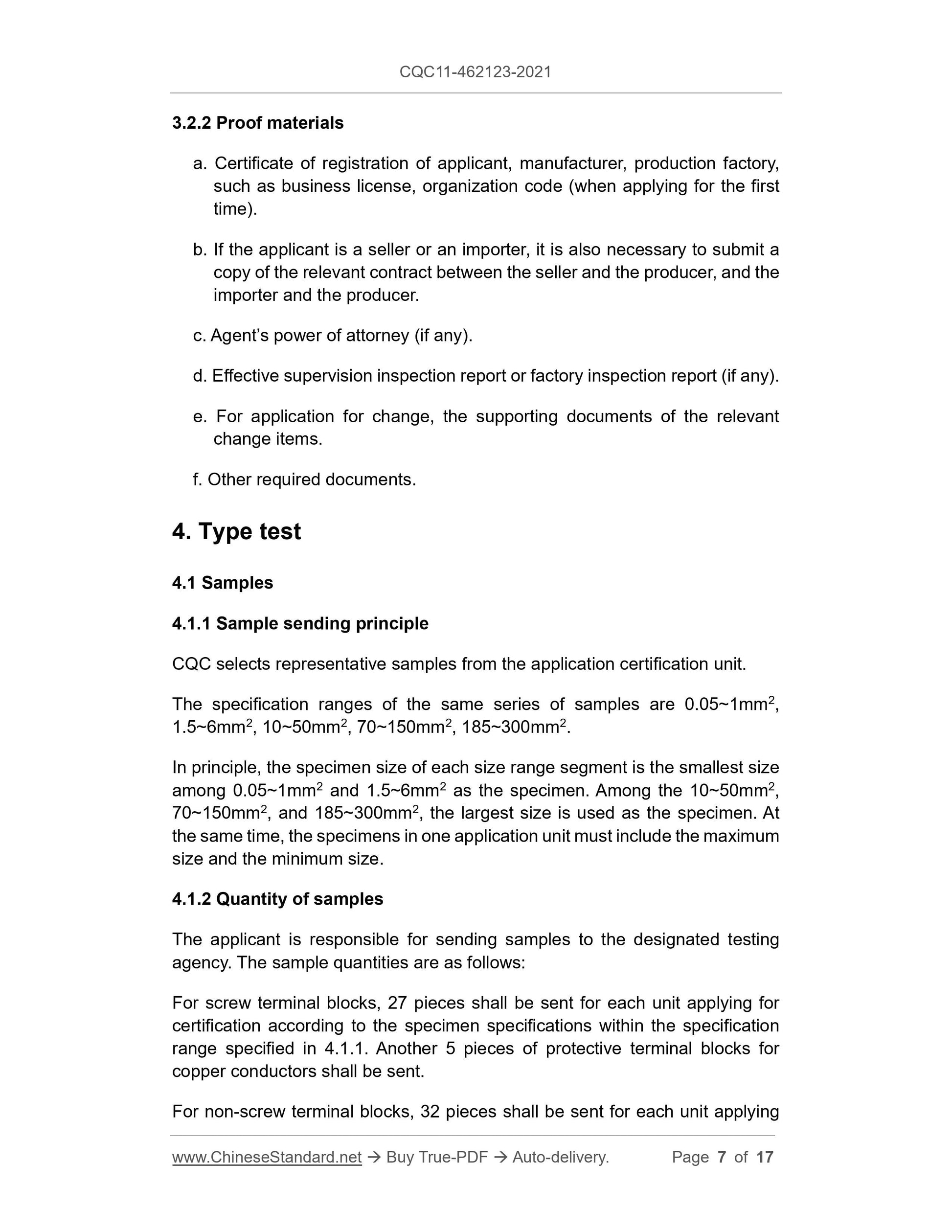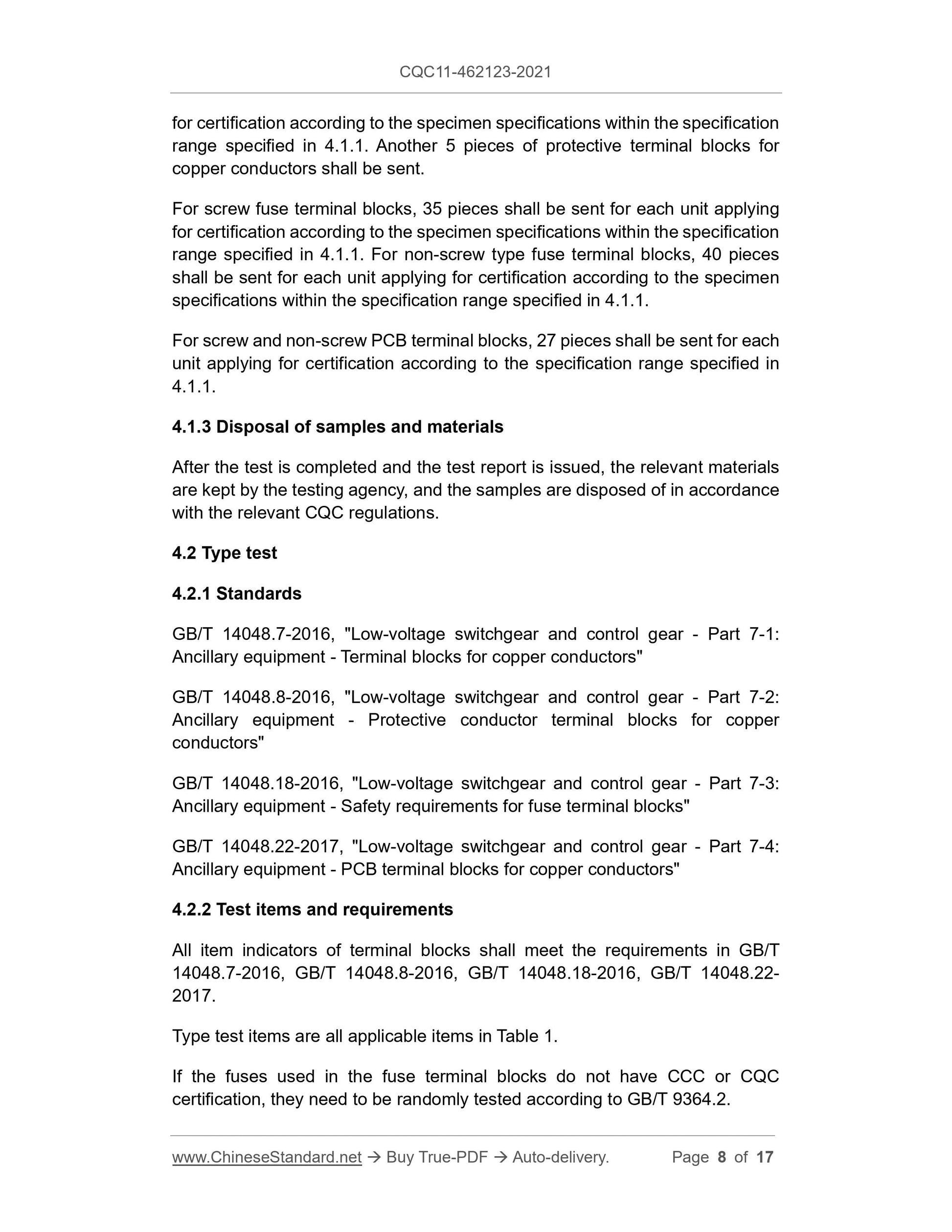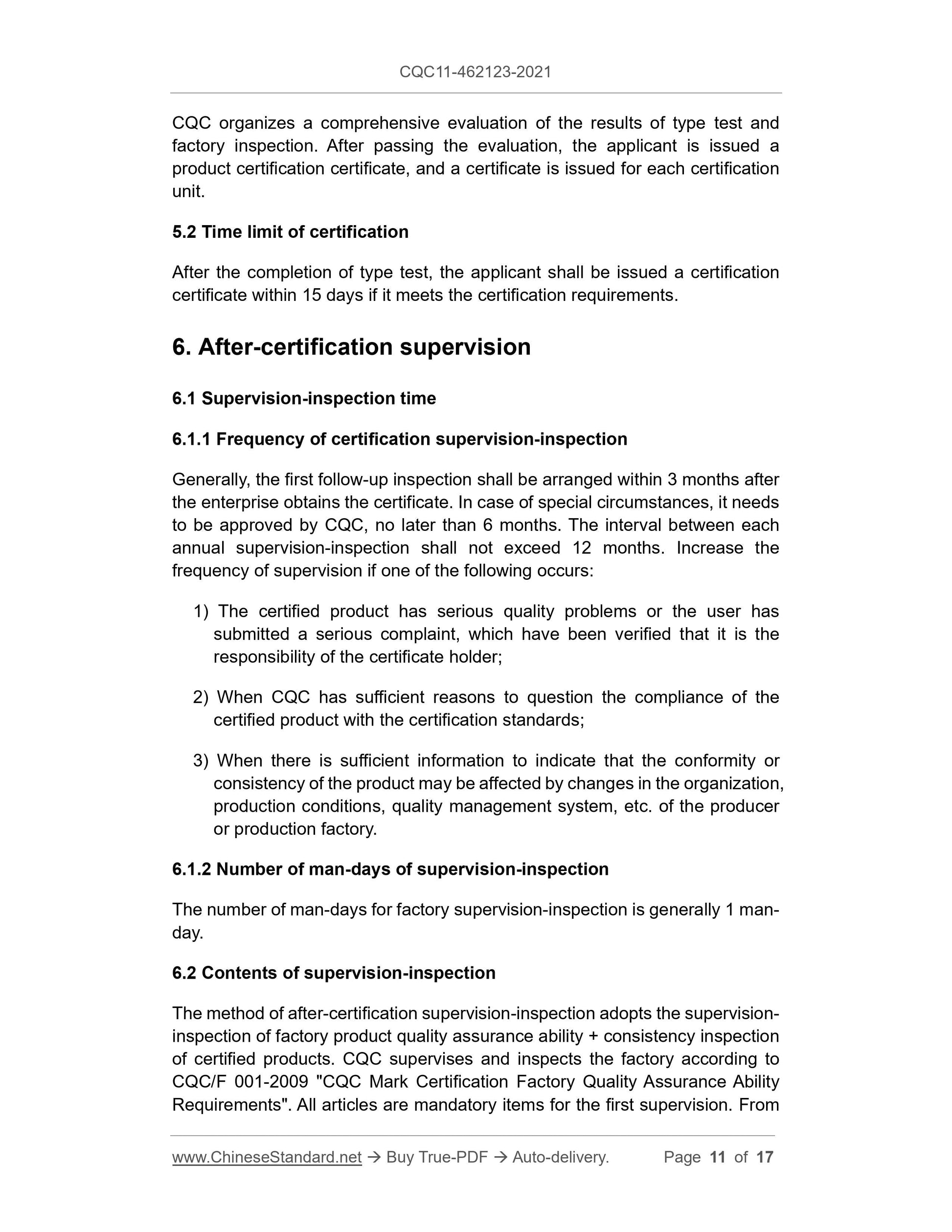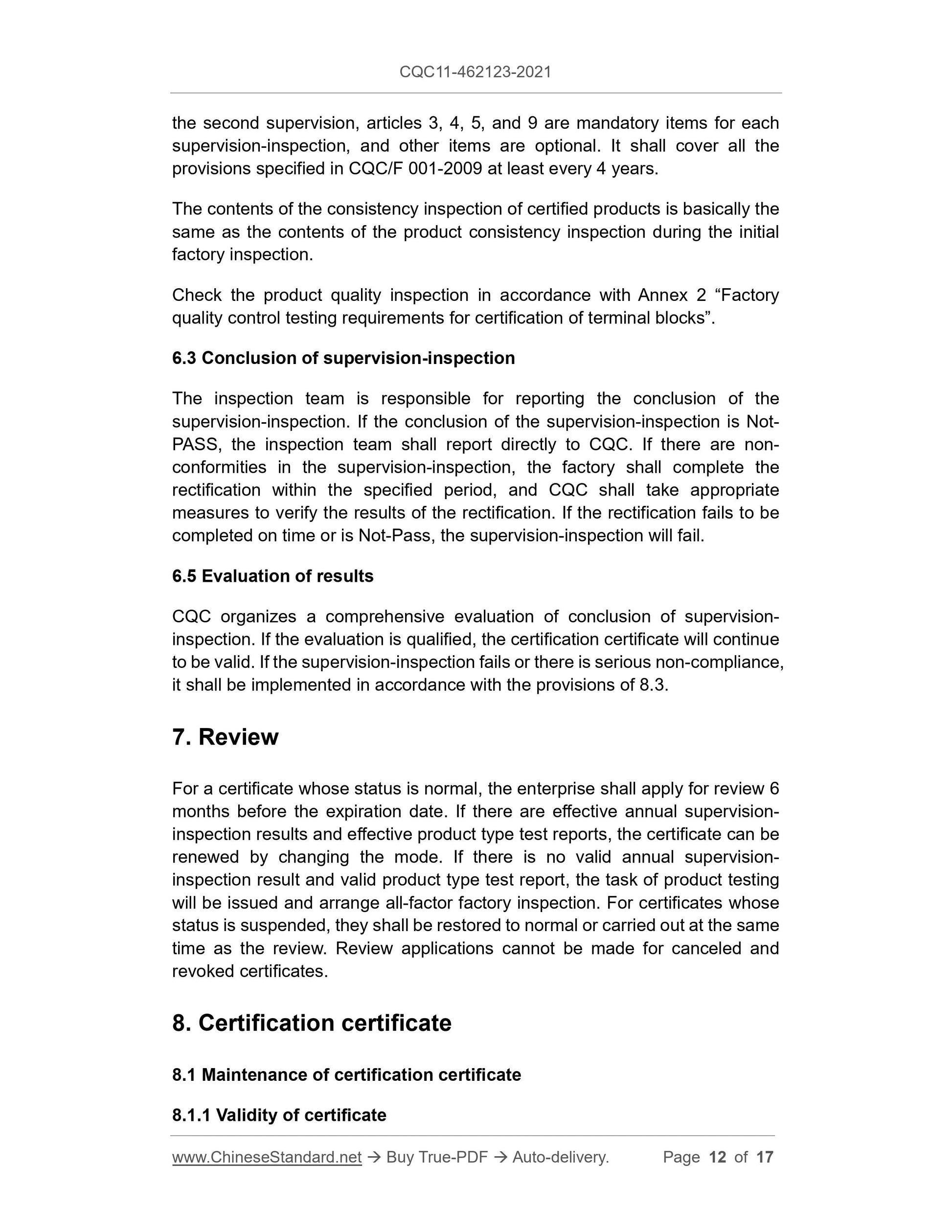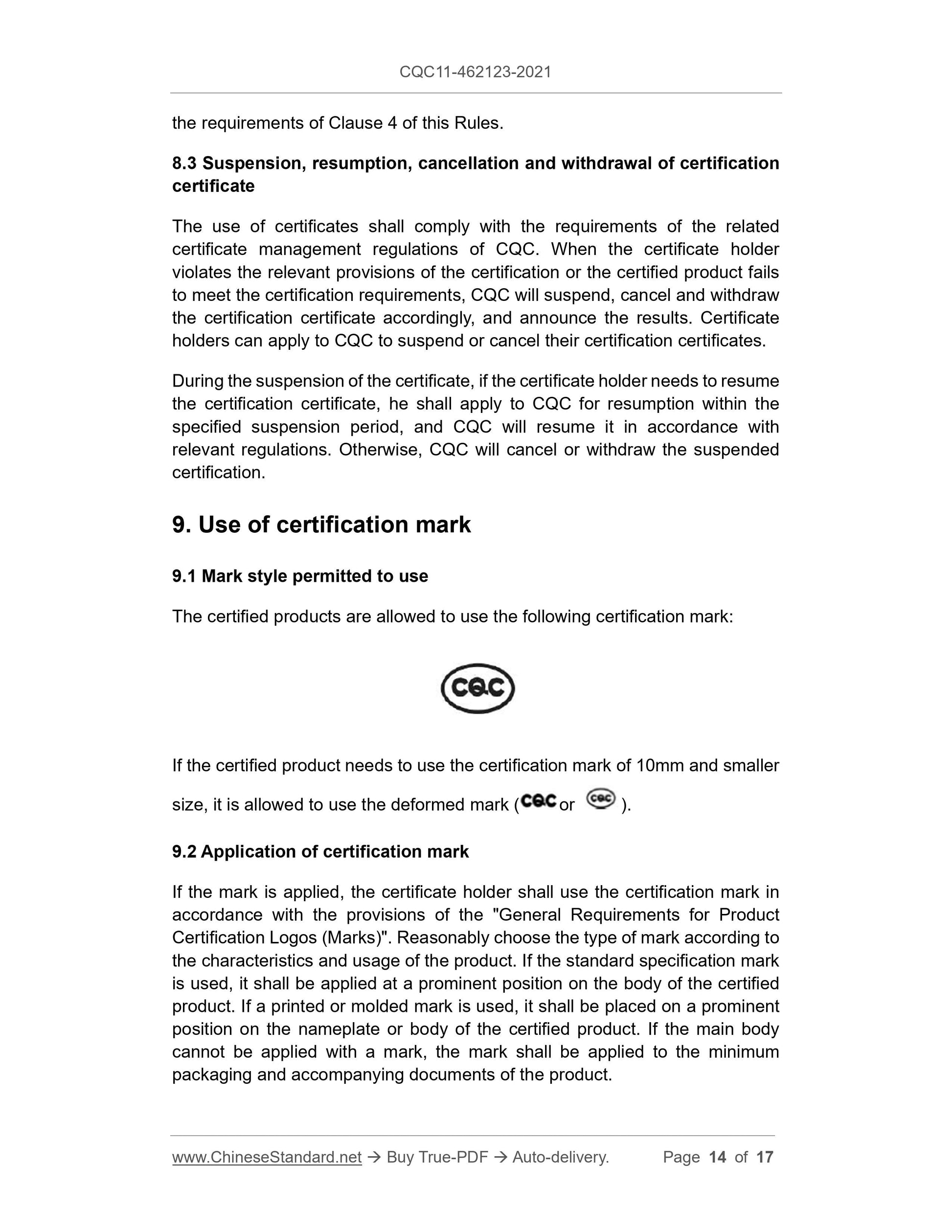1
/
의
8
PayPal, credit cards. Download editable-PDF & invoice In 1 second!
CQC11-462123-2021 English PDF (CQC11-462123-2021)
CQC11-462123-2021 English PDF (CQC11-462123-2021)
정가
$245.00 USD
정가
할인가
$245.00 USD
단가
/
단위
배송료는 결제 시 계산됩니다.
픽업 사용 가능 여부를 로드할 수 없습니다.
Delivery: 3 seconds. Download true-PDF + Invoice.
Get QUOTATION in 1-minute: Click CQC11-462123-2021
Historical versions: CQC11-462123-2021
Preview True-PDF (Reload/Scroll if blank)
CQC11-462123-2021: Safety Certification Rules for Terminal Blocks
CQC11-462123-2021
CQC
PRODUCT SAFETY CERTIFICATION RULES
Safety Certification Rules for Terminal Blocks
ISSUED ON: SEPTEMBER 1, 2021
IMPLEMENTED ON: OCTOBER 1, 2021
China Quality Certification Center
Table of Contents
Foreword ... 3
1. Scope of application ... 5
2. Certification mode ... 6
3. Certification application ... 6
4. Type test ... 7
5. Evaluation and approval of certification results ... 10
6. After-certification supervision ... 11
7. Review ... 12
8. Certification certificate ... 12
9. Use of certification mark ... 14
10. Charge ... 15
1. Scope of application
This Rules applies to the CQC safety certification of copper conductor terminal
blocks in auxiliary devices of low-voltage switchgear and control equipment,
including:
1) Industrial or similar screw-type or non-screw-type terminal blocks
mounted on brackets to provide electrical connections for copper
conductors and mechanical connections. These terminal blocks are used
in circuits with a rated voltage not exceeding 1000 V ac (1140 V), a
frequency up to 1000 Hz or 1500 V dc. They are used to connect terminal
blocks of round copper conductors with or without special processing with
a cross-sectional area of 0.2 mm2 ~ 300 mm2 (AWG24 ~ 600kcmil).
2) Protective conductor terminal blocks with screw or non-screw clamps for
industrial use. The terminal block with PE protection function shall not be
larger than 120 mm2 (250kcmil). The terminal block with PEN protection
function shall be greater than or equal to 10 mm2 (AWG8). Protective
conductor terminal blocks are used for electrical and mechanical
connection between copper conductors and mounting brackets. This
protective conductor terminal block is used in AC circuits with a voltage
not exceeding 1000 V (1140 V)) and 1000 Hz as well as in DC circuits with
a voltage not exceeding 1500 V. They are used to connect protective
conductor terminal blocks of prefabricated or non-prefabricated round
copper conductors with a cross-sectional area of 0.2 mm2 ~ 120 mm2
(AWG24 ~ 250kcmil).
3) Fuse terminal blocks with screw or non-screw clamps for connection to
solid copper conductors (single core or strands) or soft copper conductors.
This fuse terminal block carries or uses the tubular fuse described in GB/T
9364.2. It is mainly used in industrial or similar circuits with AC not
exceeding 1000V, frequency up to 1000Hz or DC not exceeding 1500V,
maximum short-circuit breaking capacity of 1500A. The fuse terminal
block is installed in the electrical equipment with the housing. There shall
be a space around the terminal block and the housing where the terminal
block can be accessed with the help of tools. In some occasions, such as
in control circuits, the fuse terminal block can be designed specifically for
short-circuit protection.
4) Printed circuit board terminal blocks for industrial or similar purposes
(hereinafter referred to as PCB terminal blocks). They are mounted and
fixed on the printed circuit board by soldering, pressing in or equivalent
methods, so as to provide electrical and mechanical connections between
copper conductors and printed circuit boards. This PCB terminal block is
3.2.2 Proof materials
a. Certificate of registration of applicant, manufacturer, production factory,
such as business license, organization code (when applying for the first
time).
b. If the applicant is a seller or an importer, it is also necessary to submit a
copy of the relevant contract between the seller and the producer, and the
importer and the producer.
c. Agent’s power of attorney (if any).
d. Effective supervision inspection report or factory inspection report (if any).
e. For application for change, the supporting documents of the relevant
change items.
f. Other required documents.
4. Type test
4.1 Samples
4.1.1 Sample sending principle
CQC selects representative samples from the application certification unit.
The specification ranges of the same series of samples are 0.05~1mm2,
1.5~6mm2, 10~50mm2, 70~150mm2, 185~300mm2.
In principle, the specimen size of each size range segment is the smallest size
among 0.05~1mm2 and 1.5~6mm2 as the specimen. Among the 10~50mm2,
70~150mm2, and 185~300mm2, the largest size is used as the specimen. At
the same time, the specimens in one application unit must include the maximum
size and the minimum size.
4.1.2 Quantity of samples
The applicant is responsible for sending samples to the designated testing
agency. The sample quantities are as follows:
For screw terminal blocks, 27 pieces shall be sent for each unit applying for
certification according to the specimen specifications within the specification
range specified in 4.1.1. Another 5 pieces of protective terminal blocks for
copper conductors shall be sent.
For non-screw terminal blocks, 32 pieces shall be sent for each unit applying
for certification according to the specimen specifications within the specification
range specified in 4.1.1. Another 5 pieces of protective terminal blocks for
copper conductors shall be sent.
For screw fuse terminal blocks, 35 pieces shall be sent for each unit applying
for certification according to the specimen specifications within the specification
range specified in 4.1.1. For non-screw type fuse terminal blocks, 40 pieces
shall be sent for each unit applying for certification according to the specimen
specifications within the specification range specified in 4.1.1.
For screw and non-screw PCB terminal blocks, 27 pieces shall be sent for each
unit applying for certification according to the specification range specified in
4.1.1.
4.1.3 Disposal of samples and materials
After the test is completed and the test report is issued, the relevant materials
are kept by the testing agency, and the samples are disposed of in accordance
with the relevant CQC regulations.
4.2 Type test
4.2.1 Standards
GB/T 14048.7-2016, "Low-voltage switchgear and control gear - Part 7-1:
Ancillary equipment - Terminal blocks for copper conductors"
GB/T 14048.8-2016, "Low-voltage switchgear and control gear - Part 7-2:
Ancillary equipment - Protective conductor terminal blocks for copper
conductors"
GB/T 14048.18-2016, "Low-voltage switchgear and control gear - Part 7-3:
Ancillary equipment - Safety requirements for fuse terminal blocks"
GB/T 14048.22-2017, "Low-voltage switchgear and control gear - Part 7-4:
Ancillary equipment - PCB terminal blocks for copper conductors"
4.2.2 Test items and requirements
All item indicators of terminal blocks shall meet the requirements in GB/T
14048.7-2016, GB/T 14048.8-2016, GB/T 14048.18-2016, GB/T 14048.22-
2017.
Type test items are all applicable items in Table 1.
If the fuses used in the fuse terminal blocks do not have CCC or CQC
certification, they need to be randomly tested according to GB/T 9364.2.
CQC organizes a comprehensive evaluation of the results of type test and
factory inspection. After passing the evaluation, the applicant is issued a
product certification certificate, and a certificate is issued for each certification
unit.
5.2 Time limit of certification
After the completion of type test, the applicant shall be issued a certification
certificate within 15 days if it meets the certification requirements.
6. After-certification supervision
6.1 Supervision-inspection time
6.1.1 Frequency of certification supervision-inspection
Generally, the first follo...
Get QUOTATION in 1-minute: Click CQC11-462123-2021
Historical versions: CQC11-462123-2021
Preview True-PDF (Reload/Scroll if blank)
CQC11-462123-2021: Safety Certification Rules for Terminal Blocks
CQC11-462123-2021
CQC
PRODUCT SAFETY CERTIFICATION RULES
Safety Certification Rules for Terminal Blocks
ISSUED ON: SEPTEMBER 1, 2021
IMPLEMENTED ON: OCTOBER 1, 2021
China Quality Certification Center
Table of Contents
Foreword ... 3
1. Scope of application ... 5
2. Certification mode ... 6
3. Certification application ... 6
4. Type test ... 7
5. Evaluation and approval of certification results ... 10
6. After-certification supervision ... 11
7. Review ... 12
8. Certification certificate ... 12
9. Use of certification mark ... 14
10. Charge ... 15
1. Scope of application
This Rules applies to the CQC safety certification of copper conductor terminal
blocks in auxiliary devices of low-voltage switchgear and control equipment,
including:
1) Industrial or similar screw-type or non-screw-type terminal blocks
mounted on brackets to provide electrical connections for copper
conductors and mechanical connections. These terminal blocks are used
in circuits with a rated voltage not exceeding 1000 V ac (1140 V), a
frequency up to 1000 Hz or 1500 V dc. They are used to connect terminal
blocks of round copper conductors with or without special processing with
a cross-sectional area of 0.2 mm2 ~ 300 mm2 (AWG24 ~ 600kcmil).
2) Protective conductor terminal blocks with screw or non-screw clamps for
industrial use. The terminal block with PE protection function shall not be
larger than 120 mm2 (250kcmil). The terminal block with PEN protection
function shall be greater than or equal to 10 mm2 (AWG8). Protective
conductor terminal blocks are used for electrical and mechanical
connection between copper conductors and mounting brackets. This
protective conductor terminal block is used in AC circuits with a voltage
not exceeding 1000 V (1140 V)) and 1000 Hz as well as in DC circuits with
a voltage not exceeding 1500 V. They are used to connect protective
conductor terminal blocks of prefabricated or non-prefabricated round
copper conductors with a cross-sectional area of 0.2 mm2 ~ 120 mm2
(AWG24 ~ 250kcmil).
3) Fuse terminal blocks with screw or non-screw clamps for connection to
solid copper conductors (single core or strands) or soft copper conductors.
This fuse terminal block carries or uses the tubular fuse described in GB/T
9364.2. It is mainly used in industrial or similar circuits with AC not
exceeding 1000V, frequency up to 1000Hz or DC not exceeding 1500V,
maximum short-circuit breaking capacity of 1500A. The fuse terminal
block is installed in the electrical equipment with the housing. There shall
be a space around the terminal block and the housing where the terminal
block can be accessed with the help of tools. In some occasions, such as
in control circuits, the fuse terminal block can be designed specifically for
short-circuit protection.
4) Printed circuit board terminal blocks for industrial or similar purposes
(hereinafter referred to as PCB terminal blocks). They are mounted and
fixed on the printed circuit board by soldering, pressing in or equivalent
methods, so as to provide electrical and mechanical connections between
copper conductors and printed circuit boards. This PCB terminal block is
3.2.2 Proof materials
a. Certificate of registration of applicant, manufacturer, production factory,
such as business license, organization code (when applying for the first
time).
b. If the applicant is a seller or an importer, it is also necessary to submit a
copy of the relevant contract between the seller and the producer, and the
importer and the producer.
c. Agent’s power of attorney (if any).
d. Effective supervision inspection report or factory inspection report (if any).
e. For application for change, the supporting documents of the relevant
change items.
f. Other required documents.
4. Type test
4.1 Samples
4.1.1 Sample sending principle
CQC selects representative samples from the application certification unit.
The specification ranges of the same series of samples are 0.05~1mm2,
1.5~6mm2, 10~50mm2, 70~150mm2, 185~300mm2.
In principle, the specimen size of each size range segment is the smallest size
among 0.05~1mm2 and 1.5~6mm2 as the specimen. Among the 10~50mm2,
70~150mm2, and 185~300mm2, the largest size is used as the specimen. At
the same time, the specimens in one application unit must include the maximum
size and the minimum size.
4.1.2 Quantity of samples
The applicant is responsible for sending samples to the designated testing
agency. The sample quantities are as follows:
For screw terminal blocks, 27 pieces shall be sent for each unit applying for
certification according to the specimen specifications within the specification
range specified in 4.1.1. Another 5 pieces of protective terminal blocks for
copper conductors shall be sent.
For non-screw terminal blocks, 32 pieces shall be sent for each unit applying
for certification according to the specimen specifications within the specification
range specified in 4.1.1. Another 5 pieces of protective terminal blocks for
copper conductors shall be sent.
For screw fuse terminal blocks, 35 pieces shall be sent for each unit applying
for certification according to the specimen specifications within the specification
range specified in 4.1.1. For non-screw type fuse terminal blocks, 40 pieces
shall be sent for each unit applying for certification according to the specimen
specifications within the specification range specified in 4.1.1.
For screw and non-screw PCB terminal blocks, 27 pieces shall be sent for each
unit applying for certification according to the specification range specified in
4.1.1.
4.1.3 Disposal of samples and materials
After the test is completed and the test report is issued, the relevant materials
are kept by the testing agency, and the samples are disposed of in accordance
with the relevant CQC regulations.
4.2 Type test
4.2.1 Standards
GB/T 14048.7-2016, "Low-voltage switchgear and control gear - Part 7-1:
Ancillary equipment - Terminal blocks for copper conductors"
GB/T 14048.8-2016, "Low-voltage switchgear and control gear - Part 7-2:
Ancillary equipment - Protective conductor terminal blocks for copper
conductors"
GB/T 14048.18-2016, "Low-voltage switchgear and control gear - Part 7-3:
Ancillary equipment - Safety requirements for fuse terminal blocks"
GB/T 14048.22-2017, "Low-voltage switchgear and control gear - Part 7-4:
Ancillary equipment - PCB terminal blocks for copper conductors"
4.2.2 Test items and requirements
All item indicators of terminal blocks shall meet the requirements in GB/T
14048.7-2016, GB/T 14048.8-2016, GB/T 14048.18-2016, GB/T 14048.22-
2017.
Type test items are all applicable items in Table 1.
If the fuses used in the fuse terminal blocks do not have CCC or CQC
certification, they need to be randomly tested according to GB/T 9364.2.
CQC organizes a comprehensive evaluation of the results of type test and
factory inspection. After passing the evaluation, the applicant is issued a
product certification certificate, and a certificate is issued for each certification
unit.
5.2 Time limit of certification
After the completion of type test, the applicant shall be issued a certification
certificate within 15 days if it meets the certification requirements.
6. After-certification supervision
6.1 Supervision-inspection time
6.1.1 Frequency of certification supervision-inspection
Generally, the first follo...
Share
